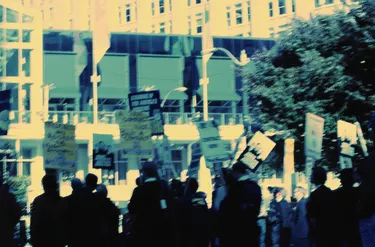
Generally speaking, workers must individually decide if wages and conditions are acceptable on their jobs, and allow the forces of the labor market to sort out pay and conditions. Occasionally, workers organize unions in attempts to collectively impact management policies. These unions have two primary tools at their disposal to influence management's decisions: collective bargaining, the process where the union negotiates contracts for all worker members simultaneously; and strikes, a tactic where union members don't report for work. As a small business owner, you must be ready to deal with both union tactics.
Worker Goals in Collective Bargaining
Video of the Day
Unions rely on the collective bargaining process to influence management policies, and use the theory of power in numbers to help sway management with more power than a single worker could. Collective bargaining is historically viewed as a tool for workers to gain higher pay, but modern-era strikes often focus as much on reducing stress and improving workplace conditions, according to Eilene Zimmerman in Workforce Magazine. Immediate improvements in pay or conditions are goals of collective bargaining, but unionized workers also wish to influence the method that management provides pay and promotions, frequently developing pay scales and promotion policies for the workplace.
Video of the Day
Union Goals in Collective Bargaining
While a union uses collective bargaining to pressure management into recognizing workers' grievances and making changes in pay and promotion policies, union officials frequently also use collective bargaining agreements to help ensure the longevity of the union itself. Unions frequently push for requirements called check-off provisions that require employers to make payroll deductions for union membership fees to help ensure funding. They also often attempt to force the company into requiring all workers be union members, a situation known as a closed or union shop.
Strikes
When unions and management can't achieve agreement at the collective bargaining table, the union may turn to its major weapon to influence corporate policy, the strike. While the goals of a strike are universal – slowing or halting production so management loses enough money to bend to the union's demands – unions employ two different types of strikes. Offensive strikes are strikes that are called to help improve union members' conditions, such as wages or work hours. Defensive strikes are strikes made in protest of wage cuts, losses of benefits and reductions in work hours.
Cost and Impacts of Strikes
Striking union members lose their individual wages each day during a strike, although may receive strike pay as a benefit from the union. A company loses productivity, either through a slowdown in work or a complete shutdown of the workforce, which obviously impacts its bottom line. A strike may be timed for a busy period to magnify its effects and place more pressure on a company. Additionally, strikes are more effective when used against companies with labor-intensive operations.